
Passiflora edulis, commonly known as passion fruit, is a vine species of passion flower native to southern Brazil through Paraguay and northern Argentina. It is cultivated commercially in tropical and subtropical areas for its sweet, seedy fruit. The fruit is a pepo, a type of berry, round to oval, either yellow or dark purple at maturity, with a soft to firm, juicy interior filled with numerous seeds. The fruit is both eaten and juiced, the juice often added to other fruit juices to enhance aroma.

Passiflora, known also as the passion flowers or passion vines, is a genus of about 550 species of flowering plants, the type genus of the family Passifloraceae.

The Passifloraceae are a family of flowering plants, containing about 750 species classified in around 27 genera.

Passiflora foetida is a species of passion flower that is native to the southwestern United States, Mexico, the Caribbean, Central America, and much of South America. It has been introduced to tropical regions around the world, such as Southeast Asia, South Asia, Hawaii, Africa, and The Maldives. It is a creeping vine like other members of the genus, and yields an edible fruit. The specific epithet, foetida, means "stinking" in Latin and refers to the strong aroma emitted by damaged foliage.
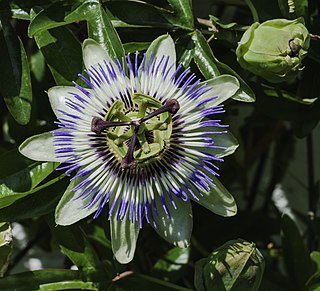
Passiflora caerulea, the blue passionflower, bluecrown passionflower or common passion flower, is a species of flowering plant native to South America. It has been introduced elsewhere. It is a vigorous, deciduous or semi-evergreen tendril vine growing to 10 m (33 ft) or more. Its leaves are palmate and fragrant, flowers blue-white with a prominent fringe of coronal filaments in bands of blue, white, and brown. The ovoid orange fruit, growing to 6 cm (2 in), is edible but bland.
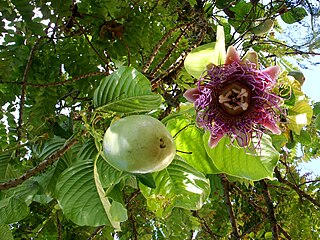
Passiflora quadrangularis, the giant granadilla, barbadine (Trinidad), grenadine (Haiti), giant tumbo or badea, is a species of plant in the family Passifloraceae. It produces the largest fruit of any species within the genus Passiflora. It is a perennial climber native to the Neotropics.
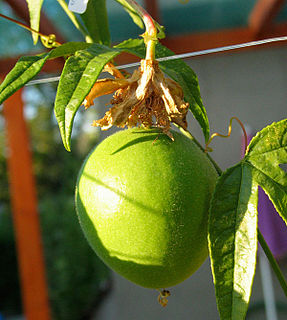
Passiflora incarnata, commonly known as maypop, purple passionflower, true passionflower, wild apricot, and wild passion vine, is a fast-growing perennial vine with climbing or trailing stems. A member of the passionflower genus Passiflora, the maypop has large, intricate flowers with prominent styles and stamens. One of the hardiest species of passionflower, it is both found as a wildflower in the southern United States and in cultivation for its fruit and striking bluish purple blooms. Passiflora incarnata fruit contain many seeds, each surrounded by an aril holding edible juice, and this juice can be consumed fresh or used to flavor processed products.
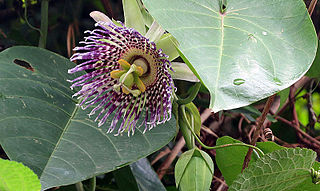
Passiflora ligularis, commonly known as the sweet granadilla or grenadia, is a plant species in the genus Passiflora. It is known as granadilla in Bolivia, Colombia, Nicaragua, Costa Rica, Ecuador, Mexico, the Azores Islands, South Africa and Peru; granadilla común in Guatemala; granadilla de China or parcha dulce in Venezuela and granaditta in Jamaica.

Ipomoea quamoclit is a species of vine in the genus Ipomoea native to tropical regions of the New World and naturalized elsewhere in the tropics.

Passiflora alata, the winged-stem passion flower, is a species of flowering plant. It is an evergreen vine, growing to 6 m (20 ft) or more, which bears an edible type of passion fruit. It is native to the Amazon, from Peru to eastern Brazil.

Butterfly World is located in Tradewinds Park in Coconut Creek, Florida, United States. It opened in 1988, and is the largest butterfly park in the world, and the first park of its kind in the Western Hemisphere. The facility houses around 20,000 live butterflies.

Vitis (grapevines) is a genus of 79 accepted species of vining plants in the flowering plant family Vitaceae. The genus is made up of species predominantly from the Northern hemisphere. It is economically important as the source of grapes, both for direct consumption of the fruit and for fermentation to produce wine. The study and cultivation of grapevines is called viticulture.

Passiflora actinia species of passion flower of the Passifloraceae. It flowers mainly in early spring, producing white, mauve and blue flowers about 9 cm wide.
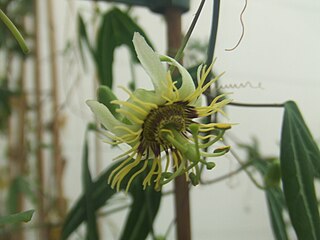
Passiflora xishuangbannaensis is a passion flower vine in the genus Passiflora that is endemic to Yunnan, China. It is a glabrous, 1–3 metres (3–10 ft) long vine with strongly two-lobed leaves. The green and yellow flowers are 3.2–3.8 centimetres in diameter when fully open, one or two flowers per node. It grows in wet and open sunny or shaded areas at 1,200 metres (3,900 ft). It was described in 2005 by Shawn E. Krosnick.

Passiflora maliformis, the sweet calabash, conch apple, wild purple passionfruit, or sweet cup, is a smallish (5cm) passionfruit with purple, yellow or green skin and a greyed-yellow to orange pulp that is aromatically-scented and -flavoured. It is a fast-growing vine, growing best in somewhat cooler-than-tropical climates. The rind is particularly hard and tougher than most passionfruits. It is usually eaten fresh or used to flavour drinks. It is a native to the Caribbean, Central America and Northern South America.

Passiflora loefgrenii, the garlic passion fruit, is a passion flower that was first formally described 1997 by Fabio Augusto Vitta. The plant is named after Albert Löfgren, the first known collector.

Passiflora coriacea, commonly known as the wild sweet calabash or bat leaved passion flower, is a tropical vine with very distinct leaves in the shape of bats' wings. It also has purple oval or circle shaped fruit that are mainly ornamental. It is a fast-growing vine to several feet. Leaves are dark green and often with splotches of light-green. White-yellow flowers with the typically ornate Passiflora appearance form when weather is warm.

Passiflora guatemalensis, the Guatemala passion vine, is a species in the family Passifloraceae. It is native to Guatemala, and found from southern Mexico through Central America to Venezuela.

Passiflora coccinea is a fast-growing vine. The vine is native to northern South America.

Cochliasanthus caracalla is a leguminous vine from the family Fabaceae, originating in tropical South America and Central America. The species is named caracalla, a corruption of the Portuguese caracol, meaning snail.





















